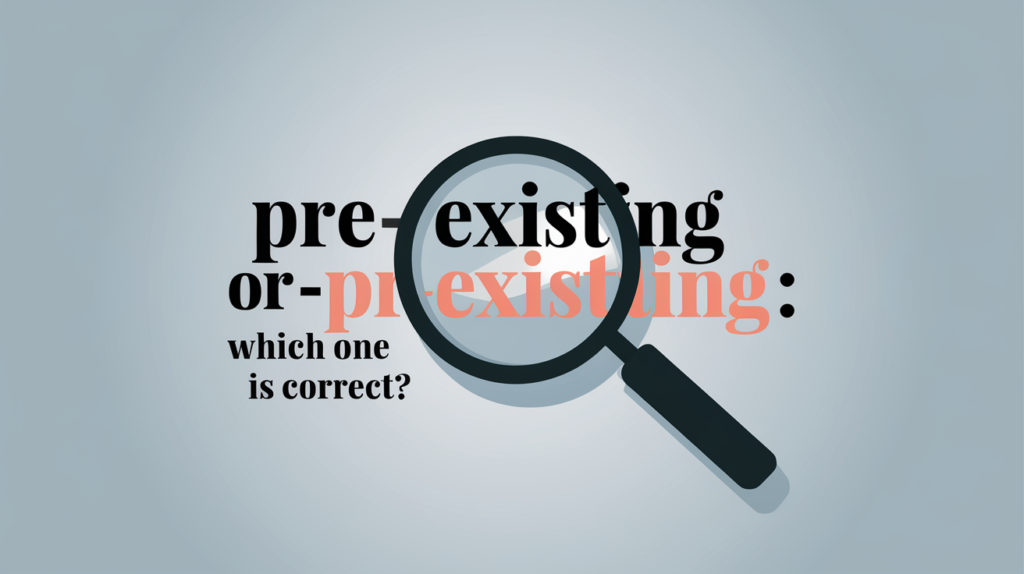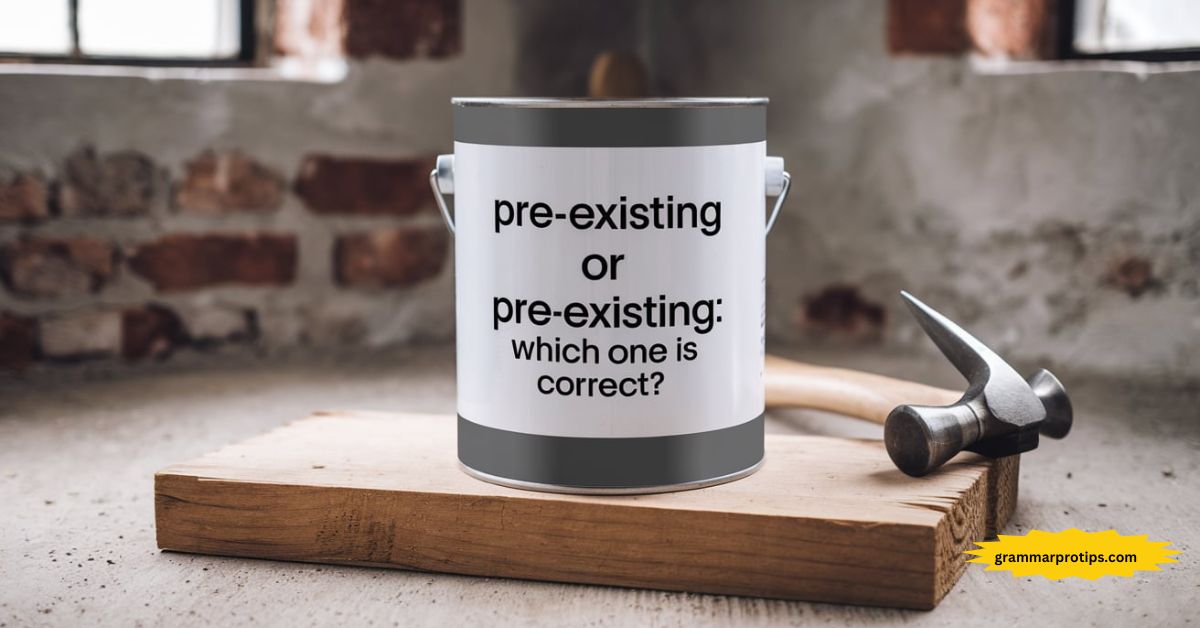When it comes to the correct use of compound words in English, the debate between pre-existing and preexisting is one that often arises. While both forms are technically accepted in the English language, which one you choose can depend on various factors such as writing style, the context, and, notably, the style guide preferences you’re following.
In this article, we’ll explore the subtle distinctions between pre-existing and preexisting, help clarify their usage, and provide some practical examples to guide you in making the right choice for your writing style.
What Are Compound Words?
Before we dive into the pre-existing vs. preexisting debate, let’s quickly cover the basics. Compound words are combinations of two or more words that function as a single unit of meaning. In English, these can appear in three main forms:
- Hyphenated form (e.g., pre-existing)
- Closed form (e.g., preexisting)
- Open form (e.g., pre existing though this is rare and less common).
In the case of pre-existing and preexisting, both are compound words formed by the prefix “pre-”, which means “before.” This prefix, when combined with the word “existing,” refers to something that exists before a specific point in time.
Hyphenated Form vs. Closed Form: The Basics
Let’s break down the two forms:
- Pre-existing: This is the hyphenated form. The hyphen makes the compound word easier to read and understand, particularly in more formal writing. It clearly links the two components of the word and ensures the reader sees it as a single idea.
- Preexisting: This is the closed form, where the hyphen is removed, and the two parts of the word are written together as one word. This form is often used in more casual contexts or when following certain style guides that prefer closed forms.
Which One is Correct?
Both pre-existing and preexisting are grammatically correct, but the choice between them often boils down to style guides, context, and audience.
Style Guide Preferences
When deciding between pre-existing and preexisting, it’s essential to consider which style guide you’re following. Different style guides may have different recommendations.
- The Chicago Manual of Style (CMS) generally favors the hyphenated form, especially when the prefix “pre-” is attached to a word that might create confusion without a hyphen.
- The Associated Press (AP) Stylebook, however, leans toward the closed form (preexisting) in most cases.
Let’s now take a look at a few scenarios that will help you understand when each form might be used.
Scenario 1: Formal Writing (Email to a Client)
Let’s say you’re writing a formal email to a client, informing them about pre-existing conditions in a legal agreement. In this case, you would likely use the hyphenated form as it provides clarity in writing and fits the tone of formal communication.
Example:
Subject: Clarification Regarding Pre-Existing Conditions in the Agreement
Dear Mr. Williams,
I hope this email finds you well. I wanted to clarify a point regarding the pre-existing conditions mentioned in the contract. These conditions refer to any circumstances that were in place before the contract’s commencement date. We have taken care to ensure all such conditions are explicitly outlined for transparency.
If you have any questions or concerns about this matter, please do not hesitate to reach out.
Best regards,
Sarah Johnson
Legal Advisor
In this example, the hyphenated form is used to provide precision and clarity, important for formal writing like legal documents and business communication.
Scenario 2: Informal Writing (Text to a Colleague)
In a more casual scenario, you might opt for the closed form, especially if you are writing to a colleague who prefers a less formal tone.
Example:
Subject: Update on the Preexisting System Issues
Hey John,
I wanted to give you a quick update on the preexisting system issues. It looks like we’ll need to address the server glitches before moving forward with the new update. I’ll keep you posted!
Cheers,
Tom
Here, the closed form of preexisting is perfectly fine since it’s a casual conversation that doesn’t require the added formality of the hyphenated version.
Pre-Existing vs Preexisting: Key Considerations

Now that we’ve explored the basic definitions and provided some examples, let’s highlight the key factors to consider when choosing between pre-existing and preexisting.
1. Clarity in Writing
The hyphenated form (pre-existing) is often clearer to the reader, particularly in more complex sentences or when the meaning could otherwise be misinterpreted. In contrast, the closed form (preexisting) is less likely to cause confusion, but it might feel more informal.
2. Audience and Context
Always consider your audience and context. If you’re writing for a formal audience (e.g., legal documents, academic writing, or professional emails), go with pre-existing. For more informal contexts, such as emails or blog posts, preexisting might be acceptable.
3. Consistency in Writing
One of the golden rules of writing is consistency. If you decide to use one form throughout a document, stick with it. Jumping between pre-existing and preexisting can confuse readers, so choose one form and maintain that choice throughout.
4. Language Evolution
Language evolves over time, and in many cases, closed forms (like preexisting) become more common in modern writing. However, both forms are still correct, and some style guides prefer the hyphenated version in specific contexts.
5. Grammar Rules and Prefix Usage
Understanding the grammar rules behind the prefix “pre-” helps. When the prefix is attached to a word where the combined meaning is still clear, the closed form is often used. But when the word might be unclear without the hyphen, the hyphenated form is preferred.
Table: Comparison of Pre-Existing and Preexisting
| Factor | Pre-Existing | Preexisting |
|---|---|---|
| Usage | More formal and clear | More casual and informal |
| Style Guides | Preferred by Chicago Manual of Style | Preferred by AP Stylebook |
| Clarity | Provides clearer meaning | Slightly less formal, but clear |
| Audience | Formal writing (e.g., legal, academic) | Informal writing (e.g., emails, blogs) |
| Consistency | Stick with hyphenated form in formal texts | Stick with closed form in informal contexts |
| Evolution | Less common in modern writing | More common in contemporary usage |
Correct Usage of Preexisting and Pre-Existing
Let’s wrap up with a few tips for correct usage of preexisting and pre-existing:
- Use pre-existing when writing formally or when clarity is a priority. This is especially true in legal, academic, or technical writing.
- Preexisting is acceptable for more casual contexts, such as blog posts, personal emails, or informal communication.
- Always check your style guide preferences. Some guides may recommend one form over the other, so be consistent with their rules.
Conclusion
Whether you choose pre-existing or preexisting depends on your audience, context, and the style guide preferences you follow. Both forms are correct, but understanding the nuances of compound word formation, prefix usage, and writing conventions will help you make the right choice for your writing clarity. Remember, consistency is key to maintaining a polished and professional piece of writing.
Ultimately, pre-existing vs preexisting boils down to the balance between formal and informal writing, language evolution, and how style guides influence your choices. So, the next time you’re unsure, consider your audience and the clarity of your message.

“Smith is the dedicated admin of [grammarprotips.com], a platform focused on enhancing grammar skills. With a passion for language and education, Smith strives to make grammar accessible and enjoyable for learners of all levels. Committed to delivering high-quality content, Smith continually explores innovative ways to help users master the complexities of grammar.”


yx0yzb
kft5rq
e2xvp6
n0awer
463hqm
9n1a7w